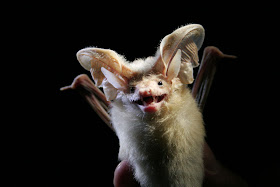The thing that most people know about scorpions is that they sting. For humans, those stings range from painful to deadly. For a smaller animal, you would expect scorpion stings to be even more deadly and even more to be avoided. But for some bats, scorpions are meals.
Hemprich’s long eared desert bat (Otonycteris hemprichii) doesn’t just make the occasional meal of a scorpion. At some points of the year, scorpions make up make up most of what they’re eating.
Holderied and colleagues looked at how the long eared desert bat is able to make a meal of scorpions, using a combination of lab and field studies. They gave the bats several choices of their potential dinners, including Leiurus quinquestriatus, which they call the yellow scorpion.
Other people call it the deathstalker.
If something was called a “deathstalker” in a movie, it would have glowing red freakin’ eyes. It would move in bullet time. And it would only carry a sword, because guns are just too noisy and inefficient. Something that you just know is going to be nasty.
And yes, this species is on the high end of the scorpion sting danger scale.
How do the desert bats catch these scorpions?
They listen for their footsteps, swoop down, and grab them, oblivious to the stings.
The bats do echolocate, like many other bats, but their echolocation calls are much quieter than those that are also using echolocation to forage for insects on the fly. There was no evidence that the bats were using these calls to glean. If the scorpion was silent and unmoving (say, a recently deceased scorpion), the bats missed it every time. The bats are using passive gleaning to hunt, rather than active. In some ways, this strategy is very similar to how barn owls hunt.
Once a bat get within range of the scorpions, they would start biting. The scorpions would try defending themselves with their stingers, but to no avail (emphasis added):
We filmed scorpions stinging bats several times sometimes on head and face, once even under an eyelid. Bats made no attempts to disable or avoid the stinger. The successful bat tore the freshly killed scorpion off the string and flew to a feeding roost to consume it. Scorpions were eaten head first, in the majority of cases including stinger and poison gland.
Even the deathstalker had no effect on the bats. When they presented bats with a choice between two species, the bats picked the more venomous species 49% of the time – about as close to a predicted random value as you’re ever likely to get in science.
The authors don’t really have a handy explanation for the scorpions’ impotence in the face of bat predators. They speculate that the stings may not be able to pierce the bat’s skin or that the bats have at least partial immunity to the scorpion venom. That the bats seem to be so indifferent to the venom, even going so far as to routinely eat it, makes me favour the latter hypothesis. At the last International Congress for Neuroethology, Ashley Rowe gave a poster just two spots down from mine talked about how grasshopper mice have developed mechanisms for resisting scorpion venom. Some of this work has been published, but isn’t cited in this paper.
Bats are the deathstalker’s stalker.
Reference
Holderied M, Korine C, & Moritz T. 2010. Hemprich’s long-eared bat (Otonycteris hemprichii) as a predator of scorpions: whispering echolocation, passive gleaning and prey selection. Journal of Comparative Physiology A. DOI: 10.1007/s00359-010-0608-3
Rowe A, Rowe M. 2008. Physiological resistance of grasshopper mice (Onychomys spp.) to Arizona bark scorpion (Centruroides exilicauda) venom Toxicon 52(5): 597-605. DOI: 10.1016/j.toxicon.2008.07.004
Bat picture by Charlotte Roemer on Wikipedia. Scorpion picture by Furryscaly on Flickr. Both used under a Creative Commons license.




Its amazing how detailed echolocation can be. I really grasped this when I was looking at a video of under a turbid river. The video imagery was produced by sound, not light, in a similar vein as echolocation. You could see the details on logs, fish moving around, it LOOKED like vision. There was no way it was vision though because the turbidity of the river was such you could only see in front of you to about 2cm.
ReplyDelete